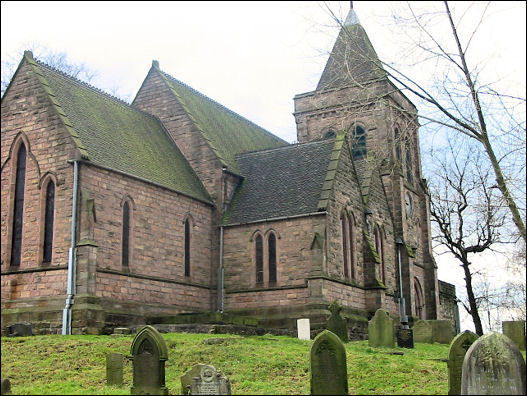|
Bucknall
Parish
this section on
Bucknall is included because of its proximity to Bentilee and the
fact that Ubberley and Eaves came under the church parish of
Bucknall-cum-Bagnall.

St
Mary's church, Bucknall
The original church was built in 1718 and
became a parish church in 1807 - this church was built in 1845-6
photo: Phil Eptlett
- Jan 2006
Description: Bucknall is situated about a mile and a half
east of Hanley. Eaves was once an adjoining hamlet to the
north-east. The area, fomerly predominantly rural with scattered
early coalworkings, is now a largely residential suburb of Hanley.
The first part of the name derives either from Bucca, a personal
name, or from the Old English ‘bucca’ meaning a buck. The second
part may be from the Old English word ‘halh’ meaning ‘hollow’ or
‘hall’. In the Domesday Book it is called Buchenole and was part of
the lands of the Crown
In 1327 the lay subsidy, a tax imposed to
raise money for Edward III’s Scottish war, lists 18 people in
‘Buckenale’ . Most of these can probably be considered as a family
unit. The Hearth Tax returns of 1666 indicate quite a large
population for the time. 41 households were assessed as chargeable
for tax, including the house of John Beech which had five hearths.
Two of them were “stopt upp”. A further 29 households were
considered not chargeable for tax. The returns would have included
Eaves and Ubberley but not Bagnall which is separately listed. By
1841 the population was 1,608. 638 of these were in the village of
Bucknall, 382 in Eaves and 214 in Ubberley.
The parish church of St Mary dates from 1856. The architects were
Ward and Son of Hanley. This church replaced an earlier building of
1718, said to have included building materials from the former
Hulton Abbey. There was also a New Connexion Methodist chapel at
Bucknall, built in 1824 and Wesleyan and Primitive Methodist chapels
at Townsend.
The main estate in Eaves was called The Ash and a large house called
Ash Hall was built on a site overlooking Bucknall by Job Meigh, a
local landowner. It was considered to have ‘every purpose of
domestic comfort, very few modern houses will bear comparison’. A
half-timbered house, Brook House, which stood formerly on Brookhouse
Lane, was removed from the village in 1974 and rebuilt at Knighton
near Adbaston.
Coalworking in the area dates back to the Middle Ages when the
Cistercian monks at Hulton Abbey worked surface outcrops of coal in
the Bucknall area. Later coal was exploited through the development
of the Hanley and Bucknall Colliery, Mossfield Colliery, Jubilee Pit
and Lillydale Colliery but these had been effectively worked out by
the end of the 19th century. The area supported the pottery industry
through the location of water-powered flint mills at Bucknall Bridge
and at Mossfield.
Bucknall Hospital was originally the City’s infectious diseases
hospital and this is probably an indication of a reasonably healthy
as well as a rural environment. The village had a station on the
North Staffs section of the London, Midland and Scottish Railway.
Finney Gardens was established for the purposes of public recreation
by 1890.
A school was founded in 1719 under the will of
William Shawcross for 12 poor children. It was situated next to the
churchyard. By the mid 19th century the school had become known as
Bucknall National School. However by 1868 the building was in poor
condition and a new school was built close by. This was designed by
Henry Ward, who had designed Stoke Town Hall. The land for this
building was donated by John Tomlinson. Eventually this school
became known as the Bucknall CE ( C) School. In 1974 a new school
building was built and the school became known as Marychurch.
Trade directories for the first half of the 20th century indicate a
very wide variety of trades and minor industry in Bucknall, such as
the saw mills, as well as a number if farmers in the more outlying
areas.
The local wakes in Bucknall were known as the Pickled Onion Wakes
because the local publicans used to cater for those attending with
pickled onions and cheese.
text
© Staffordshire Past Tracks

|
![]()
![]()
![]()